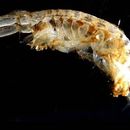en
names in breadcrumbs


Corophium volutator is a species of amphipod crustacean in the family Corophiidae.[2] It is found in mudflats of the northern Atlantic Ocean.[3] It is native to the north-east Atlantic Ocean, and has been introduced to the north-west Atlantic.[4]
Corophium volutator is a slender animal, up to 11 millimetres (0.43 in) long, "whitish with brown markings".[5] The head bear two pairs of antennae, the first of which are small and point forwards, while the distinctive second pair are much longer and thicker.[5]
There are 1–2 generations per year,[6] and the females brood the eggs inside their brood pouch or marsupium.[7] They can occur in huge quantities: up to 60,000 per square metre have been observed.[7]
Corophium volutator is a species of amphipod crustacean in the family Corophiidae. It is found in mudflats of the northern Atlantic Ocean. It is native to the north-east Atlantic Ocean, and has been introduced to the north-west Atlantic.